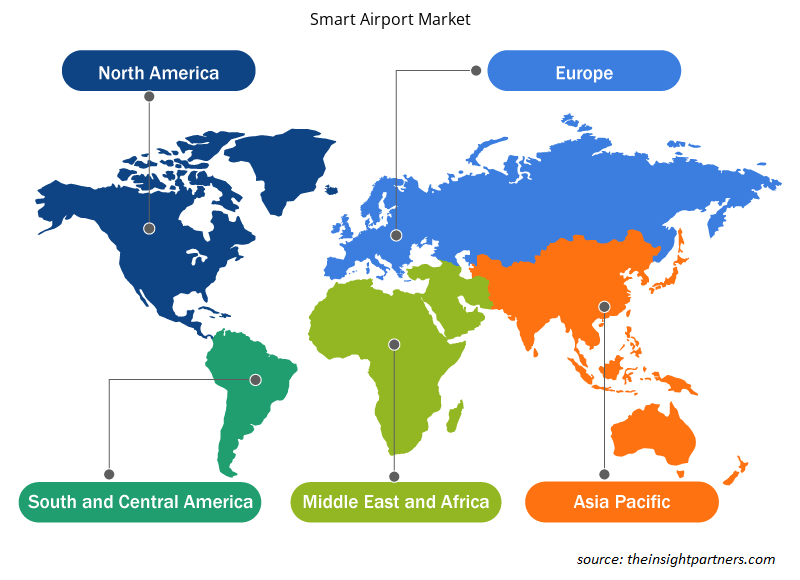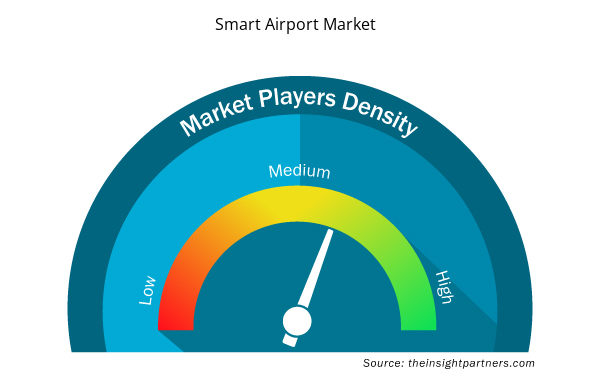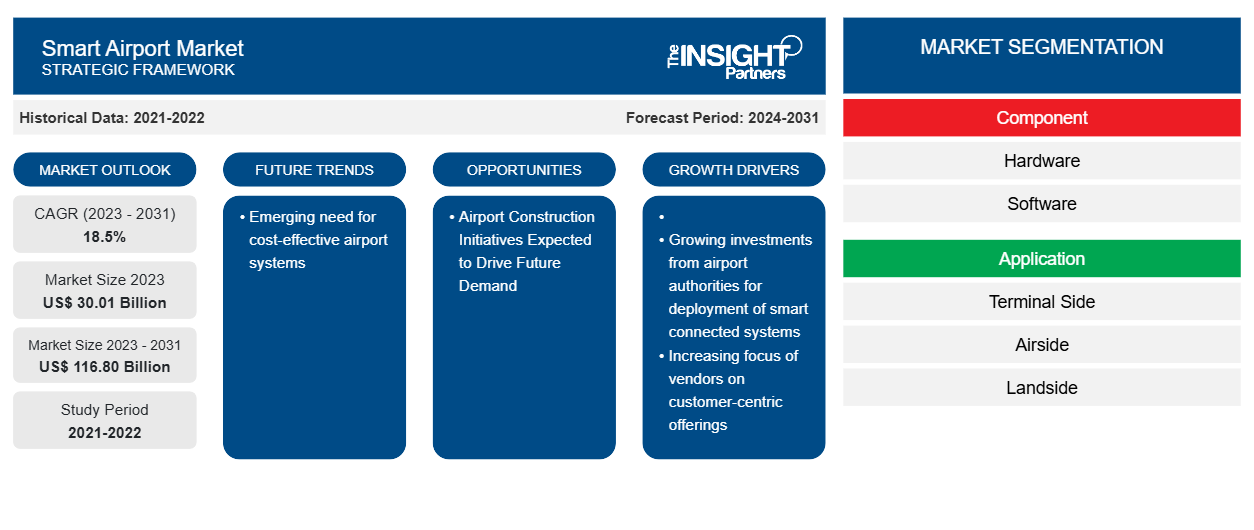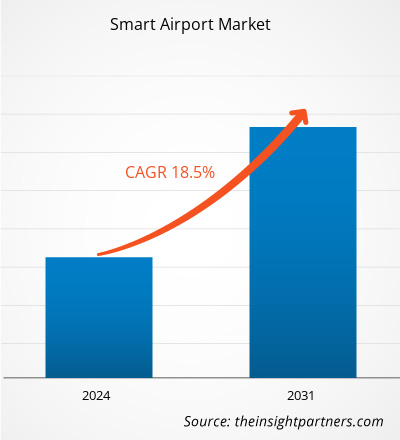من المتوقع أن يصل حجم سوق المطارات الذكية إلى 116.80 مليار دولار أمريكي بحلول عام 2031 من 30.01 مليار دولار أمريكي في عام 2023. ومن المتوقع أن يسجل السوق معدل نمو سنوي مركب بنسبة 18.5٪ خلال الفترة 2023-2031. ومن المرجح أن تظل الحاجة الناشئة إلى أنظمة مطارات فعالة من حيث التكلفة اتجاهًا رئيسيًا في السوق.
تحليل سوق المطارات الذكية
تستعين المطارات بالحلول والخدمات من مصنعي أنظمة المطارات الذكية. ويتزايد الطلب على الأنظمة الآلية للمطارات الذكية بسبب الاستثمارات المتزايدة في نشر الأنظمة القائمة على الذكاء الاصطناعي والتعلم الآلي عبر المطارات المختلفة. وقد وقع مصنعو المكونات في نظام المطارات الذكية عقودًا قصيرة وطويلة الأجل مع مصنعي أجهزة التكنولوجيا الذكية، مثل أنظمة معالجة البيانات الذكية، والذكاء الاصطناعي ، وأجهزة استشعار إنترنت الأشياء ، وأجهزة المودم، وأجهزة التوجيه، وأجهزة الاستشعار التي يتم تقشيرها ولصقها.Amadeus IT Group SA؛ Cisco System, Inc؛ Huawei Technologies Co., Ltd؛ Honeywell International Inc.؛ Indra Sistemas SA؛ SABRE GLBL Inc.؛ Jeppesen ؛ Zensors ؛ و SITA هم مقدمو أنظمة المطارات الذكية. توفر هذه الشركات أجهزة وخدمات وحلول ذكية شاملة للمستخدمين النهائيين المستهدفين. يشمل المستخدمون النهائيون الرئيسيون لأنظمة المطارات الذكية مطار شانغي في سنغافورة ومطار إنتشون في سيول ومطارات هيوستن ومطار طوكيو هانيدا ومطار هونج كونج الدولي ومطار حمد الدولي في الدوحة ومطار ميونيخ ومطار هيثرو في لندن .
نظرة عامة على سوق المطارات الذكية
تشمل الجهات المعنية الرئيسية في منظومة سوق المطارات الذكية مصنعي وموردي المكونات ومطوري البرامج والمتكاملين ومصنعي أنظمة المطارات الذكية والمستخدمين النهائيين. تشمل الشركات المصنعة والموردين للمكونات Astronics Corporation وTE Connectivity و Molex و Panduit وHoneywell وSchneider Electric وغيرها. تعمل الاستثمارات الحكومية المتزايدة في إنشاء المطارات الذكية على تسريع رقمنة المطارات. يعد الأمان أمرًا بالغ الأهمية في المطارات الذكية؛ وبالتالي، تعمل العديد من سلطات المطارات الذكية معًا لتأمين هذه المرافق وتحسين كفاءتها التشغيلية.
قم بتخصيص هذا التقرير ليناسب متطلباتك
ستحصل على تخصيص لأي تقرير - مجانًا - بما في ذلك أجزاء من هذا التقرير، أو تحليل على مستوى الدولة، وحزمة بيانات Excel، بالإضافة إلى الاستفادة من العروض والخصومات الرائعة للشركات الناشئة والجامعات
- احصل على أهم اتجاهات السوق الرئيسية لهذا التقرير.ستتضمن هذه العينة المجانية تحليلاً للبيانات، بدءًا من اتجاهات السوق وحتى التقديرات والتوقعات.
محركات وفرص سوق المطارات الذكية
زيادة تركيز البائعين في السوق على العروض الموجهة للعملاء
تركز الشركات في صناعة المطارات الذكية على تقديم حلول تركز على العملاء لتعزيز تبني تقنيات المطارات الذكية. يتزايد طلب الركاب على تتبع الأمتعة في جميع أنحاء العالم، وهو أحد مجالات التركيز الرئيسية لسلطات المطارات. وفقًا لإدارة الطيران المدني الصينية ( CAAC )، في عام 2021، أراد حوالي 75٪ من ركاب الطائرات في الصين معرفة تفاصيل تتبع أمتعتهم ووقت الاستلام. وفقًا لنفس البحث، تركز حوالي 86٪ من شركات الطيران في الصين على تقديم إشعارات تتبع الأمتعة، كما توفر 57٪ من شركات الطيران معلومات عن استلام الأمتعة لركابها في جميع أنحاء الصين. وبالتالي، يركز البائعون في سوق المطارات الذكية على توفير أنظمة إدارة الأمتعة الذكية لشركات الطيران لأتمتة عملياتها التجارية وتوفير تجربة أفضل للركاب. يتم دمج هذه الأنظمة مع تطبيقات وقواعد بيانات شركات الطيران المستندة إلى السحابة، والتحليلات المستندة إلى السحابة ، ومنصة آلة إلى آلة (M2M) وإنترنت الأشياء (IoT) لتوصيل وإدارة وتأمين البيانات والأحداث في الوقت الفعلي من الأمتعة الذكية. وعلاوة على ذلك، يساعد نشر أنظمة إدارة الأمتعة في المطارات أيضًا على تقليل التكاليف التشغيلية الإجمالية، إلى جانب تعزيز الكفاءة التشغيلية الشاملة.
مشاريع بناء مطار جديد
من المرجح أن يؤدي ارتفاع عدد مشاريع بناء المطارات في البلدان الناشئة مثل الصين والهند إلى توليد فرص جديدة لبائعي السوق في السنوات القادمة. تعد العديد من الخطط الحكومية المتعلقة ببناء مطارات جديدة وتوسيع / ترقية المطارات الحالية من العوامل الرئيسية الأخرى التي من المرجح أن تدعم نشر أنظمة المطارات الذكية في السنوات القادمة. على سبيل المثال، أعلنت الحكومة الهندية في عام 2022 بالفعل عن خططها لبناء 220 مطارًا بحلول نهاية عام 2025. وعلاوة على ذلك، في عام 2018، أعلنت إدارة الطيران المدني الصينية ( CAAC ) عن خططها لبناء 216 مطارًا جديدًا بحلول نهاية عام 2035 مما يجعل إجمالي عدد المطارات 450 مطارًا بحلول عام 2035 (234 مطارًا حاليًا في عام 2023). من المرجح أن تولد مثل هذه المشاريع فرصًا جديدة لشركات تكنولوجيا المطارات الذكية في السنوات القادمة.
تقرير تحليل تجزئة سوق المطارات الذكية
إن القطاعات الرئيسية التي ساهمت في استخلاص تحليل سوق المطار الذكي هي المكون والتطبيق.
- بناءً على المكونات، ينقسم سوق المطارات الذكية إلى أجهزة وبرامج. وينقسم قطاع الأجهزة إلى أنظمة الأمان وأنظمة الاتصالات والملاحة وأجهزة نقاط النهاية وأنظمة تخزين البيانات. وقد احتل قطاع الأجهزة حصة سوقية أكبر في عام 2023.
- بناءً على التطبيق، يتم تقسيم سوق المطارات الذكية إلى جانب المحطة، وجانب الجو، وجانب الأرض. احتلت شريحة جانب المحطة حصة سوقية أكبر في عام 2023.
تحليل حصة سوق المطارات الذكية حسب المنطقة الجغرافية
ينقسم النطاق الجغرافي لتقرير سوق المطارات الذكية بشكل أساسي إلى خمس مناطق: أمريكا الشمالية، وأوروبا، ومنطقة آسيا والمحيط الهادئ، والشرق الأوسط وأفريقيا، وأمريكا الجنوبية.
سيطرت منطقة آسيا والمحيط الهادئ على السوق في عام 2023 تليها أوروبا وأمريكا الشمالية. علاوة على ذلك، من المرجح أن تشهد منطقة آسيا والمحيط الهادئ أعلى معدل نمو سنوي مركب في السنوات القادمة. المحرك الرئيسي لسوق المطارات الذكية في منطقة آسيا والمحيط الهادئ هو وجود عدد كبير من مشاريع المطارات الذكية في جميع أنحاء المنطقة. على سبيل المثال، بعض المطارات الذكية الرئيسية الموجودة في منطقة آسيا والمحيط الهادئ هي مطار هونج كونج الدولي، ومطار شنتشن، ومطار بكين داشينغ الدولي، ومطار طوكيو هانيدا، ومطار سنتراير ناغويا الدولي، ومطار نيودلهي الدولي، ومطار حيدر أباد الدولي، ومطار سيول إنتشون، ومطار جيجو، ومطار سنغافورة شانغي، ومطار كوالالمبور الدولي، ومطار إندونيسيا. علاوة على ذلك، من المرجح أن تقوم دول مثل الصين والهند ببناء أكثر من 400 مطار بحلول نهاية عام 2035، وهو ما من المرجح أن يدفع السوق في السنوات القادمة.
رؤى إقليمية حول سوق المطارات الذكية
لقد قام المحللون في Insight Partners بشرح الاتجاهات والعوامل الإقليمية المؤثرة على سوق المطارات الذكية طوال فترة التوقعات بشكل شامل. يناقش هذا القسم أيضًا قطاعات سوق المطارات الذكية والجغرافيا في جميع أنحاء أمريكا الشمالية وأوروبا ومنطقة آسيا والمحيط الهادئ والشرق الأوسط وأفريقيا وأمريكا الجنوبية والوسطى.

- احصل على البيانات الإقليمية المحددة لسوق المطارات الذكية
نطاق تقرير سوق المطارات الذكية
| سمة التقرير | تفاصيل |
|---|---|
| حجم السوق في عام 2023 | 30.01 مليار دولار أمريكي |
| حجم السوق بحلول عام 2031 | 116.80 مليار دولار أمريكي |
| معدل النمو السنوي المركب العالمي (2023 - 2031) | 18.5% |
| البيانات التاريخية | 2021-2022 |
| فترة التنبؤ | 2024-2031 |
| القطاعات المغطاة | حسب المكون
|
| المناطق والدول المغطاة | أمريكا الشمالية
|
| قادة السوق وملفات تعريف الشركات الرئيسية |
|
كثافة اللاعبين في السوق: فهم تأثيرها على ديناميكيات الأعمال
يشهد سوق المطارات الذكية نموًا سريعًا، مدفوعًا بالطلب المتزايد من جانب المستخدم النهائي بسبب عوامل مثل تفضيلات المستهلكين المتطورة والتقدم التكنولوجي والوعي المتزايد بفوائد المنتج. ومع ارتفاع الطلب، تعمل الشركات على توسيع عروضها والابتكار لتلبية احتياجات المستهلكين والاستفادة من الاتجاهات الناشئة، مما يؤدي إلى زيادة نمو السوق.
تشير كثافة اللاعبين في السوق إلى توزيع الشركات أو المؤسسات العاملة في سوق أو صناعة معينة. وهي تشير إلى عدد المنافسين (اللاعبين في السوق) الموجودين في مساحة سوق معينة نسبة إلى حجمها أو قيمتها السوقية الإجمالية.
الشركات الرئيسية العاملة في سوق المطارات الذكية هي:
- شركة هونيويل الدولية
- شركة سيسكو سيستمز
- شركة هواوي للتكنولوجيا المحدودة
- شركة إندرا سيستيماس إس إيه
- مجموعة أماديوس لتكنولوجيا المعلومات
- سيتا
إخلاء المسؤولية : الشركات المذكورة أعلاه ليست مرتبة بأي ترتيب معين.

- احصل على نظرة عامة على أهم اللاعبين الرئيسيين في سوق المطارات الذكية
أخبار سوق المطارات الذكية والتطورات الأخيرة
يتم تقييم سوق المطارات الذكية من خلال جمع البيانات النوعية والكمية بعد البحث الأولي والثانوي، والتي تتضمن منشورات الشركات المهمة وبيانات الجمعيات وقواعد البيانات. فيما يلي بعض التطورات في سوق المطارات الذكية:
حصلت شركة تاليس على عقد من مجموعة إدارة المطارات SEA (Società per azioni Esercizi Aeroportuali) لتقديم حل منصة رقمية مبتكرة من شأنها دعم المجموعة في تعزيز الكفاءة التشغيلية. (المصدر: تاليس، بيان صحفي، مارس 2022)
- خلال معرض Airports Innovate الأول، الذي يقام في الفترة من 20 إلى 22 نوفمبر في مسقط، عُمان، أطلقت هواوي سلسلة من حلول المطارات الذكية الجديدة كليًا للأسواق الدولية، بما في ذلك حل شبكة الألياف المتصلة بالكامل وأمن محيط المطار الذكي باستخدام حل استشعار الألياف. (المصدر: هواوي، بيان صحفي، نوفمبر 2023)
تقرير سوق المطارات الذكية: التغطية والنتائج المتوقعة
يوفر تقرير "حجم سوق المطارات الذكية والتوقعات (2021-2031)" تحليلاً مفصلاً للسوق يغطي المجالات التالية:
- حجم سوق المطارات الذكية وتوقعاتها على المستويات العالمية والإقليمية والوطنية لجميع قطاعات السوق الرئيسية التي يغطيها النطاق
- اتجاهات سوق المطارات الذكية بالإضافة إلى ديناميكيات السوق مثل المحركات والقيود والفرص الرئيسية
- تحليل مفصل لقوى بورتر الخمس
- تحليل سوق المطارات الذكية يغطي اتجاهات السوق الرئيسية والإطار العالمي والإقليمي والجهات الفاعلة الرئيسية واللوائح والتطورات الأخيرة في السوق
- تحليل المشهد الصناعي والمنافسة الذي يغطي تركيز السوق، وتحليل خريطة الحرارة، واللاعبين البارزين، والتطورات الأخيرة لسوق المطارات الذكية
- ملفات تعريف الشركة التفصيلية
- التحليل التاريخي (سنتان)، السنة الأساسية، التوقعات (7 سنوات) مع معدل النمو السنوي المركب
- تحليل PEST و SWOT
- حجم السوق والقيمة / الحجم - عالميًا وإقليميًا وقطريًا
- الصناعة والمنافسة
- مجموعة بيانات Excel



Report Coverage
Revenue forecast, Company Analysis, Industry landscape, Growth factors, and Trends

Segment Covered
This text is related
to segments covered.

Regional Scope
North America, Europe, Asia Pacific, Middle East & Africa, South & Central America

Country Scope
This text is related
to country scope.
الأسئلة الشائعة
Asia Pacific region dominated the smart airport market in 2023.
Growing investments from airport authorities for deployment of smart connected systems and increasing focus of vendors on customer-centric offerings are some of the factors driving the growth for smart airport market.
Emerging need for cost-effective airport systems is one of the major trends of the market.
Honeywell International Inc, Cisco Systems Inc, Huawei Technologies Co Ltd, Indra Sistemas SA, Amadeus IT Group SA, SITA, Collins Aerospace, Daifuku Co Ltd, Thales Group, and T-Systems International GmbH are some of the key players profiled under the report.
The estimated value of the smart airport market by 2031 would be around US$ 116.80 billion.
The smart airport market is likely to register of 18.5% during 2023-2031.
Trends and growth analysis reports related to Aerospace and Defense : READ MORE..
The Insight Partners performs research in 4 major stages: Data Collection & Secondary Research, Primary Research, Data Analysis and Data Triangulation & Final Review.
- Data Collection and Secondary Research:
As a market research and consulting firm operating from a decade, we have published and advised several client across the globe. First step for any study will start with an assessment of currently available data and insights from existing reports. Further, historical and current market information is collected from Investor Presentations, Annual Reports, SEC Filings, etc., and other information related to company’s performance and market positioning are gathered from Paid Databases (Factiva, Hoovers, and Reuters) and various other publications available in public domain.
Several associations trade associates, technical forums, institutes, societies and organization are accessed to gain technical as well as market related insights through their publications such as research papers, blogs and press releases related to the studies are referred to get cues about the market. Further, white papers, journals, magazines, and other news articles published in last 3 years are scrutinized and analyzed to understand the current market trends.
- Primary Research:
The primarily interview analysis comprise of data obtained from industry participants interview and answers to survey questions gathered by in-house primary team.
For primary research, interviews are conducted with industry experts/CEOs/Marketing Managers/VPs/Subject Matter Experts from both demand and supply side to get a 360-degree view of the market. The primary team conducts several interviews based on the complexity of the markets to understand the various market trends and dynamics which makes research more credible and precise.
A typical research interview fulfils the following functions:
- Provides first-hand information on the market size, market trends, growth trends, competitive landscape, and outlook
- Validates and strengthens in-house secondary research findings
- Develops the analysis team’s expertise and market understanding
Primary research involves email interactions and telephone interviews for each market, category, segment, and sub-segment across geographies. The participants who typically take part in such a process include, but are not limited to:
- Industry participants: VPs, business development managers, market intelligence managers and national sales managers
- Outside experts: Valuation experts, research analysts and key opinion leaders specializing in the electronics and semiconductor industry.
Below is the breakup of our primary respondents by company, designation, and region:

Once we receive the confirmation from primary research sources or primary respondents, we finalize the base year market estimation and forecast the data as per the macroeconomic and microeconomic factors assessed during data collection.
- Data Analysis:
Once data is validated through both secondary as well as primary respondents, we finalize the market estimations by hypothesis formulation and factor analysis at regional and country level.
- Macro-Economic Factor Analysis:
We analyse macroeconomic indicators such the gross domestic product (GDP), increase in the demand for goods and services across industries, technological advancement, regional economic growth, governmental policies, the influence of COVID-19, PEST analysis, and other aspects. This analysis aids in setting benchmarks for various nations/regions and approximating market splits. Additionally, the general trend of the aforementioned components aid in determining the market's development possibilities.
- Country Level Data:
Various factors that are especially aligned to the country are taken into account to determine the market size for a certain area and country, including the presence of vendors, such as headquarters and offices, the country's GDP, demand patterns, and industry growth. To comprehend the market dynamics for the nation, a number of growth variables, inhibitors, application areas, and current market trends are researched. The aforementioned elements aid in determining the country's overall market's growth potential.
- Company Profile:
The “Table of Contents” is formulated by listing and analyzing more than 25 - 30 companies operating in the market ecosystem across geographies. However, we profile only 10 companies as a standard practice in our syndicate reports. These 10 companies comprise leading, emerging, and regional players. Nonetheless, our analysis is not restricted to the 10 listed companies, we also analyze other companies present in the market to develop a holistic view and understand the prevailing trends. The “Company Profiles” section in the report covers key facts, business description, products & services, financial information, SWOT analysis, and key developments. The financial information presented is extracted from the annual reports and official documents of the publicly listed companies. Upon collecting the information for the sections of respective companies, we verify them via various primary sources and then compile the data in respective company profiles. The company level information helps us in deriving the base number as well as in forecasting the market size.
- Developing Base Number:
Aggregation of sales statistics (2020-2022) and macro-economic factor, and other secondary and primary research insights are utilized to arrive at base number and related market shares for 2022. The data gaps are identified in this step and relevant market data is analyzed, collected from paid primary interviews or databases. On finalizing the base year market size, forecasts are developed on the basis of macro-economic, industry and market growth factors and company level analysis.
- Data Triangulation and Final Review:
The market findings and base year market size calculations are validated from supply as well as demand side. Demand side validations are based on macro-economic factor analysis and benchmarks for respective regions and countries. In case of supply side validations, revenues of major companies are estimated (in case not available) based on industry benchmark, approximate number of employees, product portfolio, and primary interviews revenues are gathered. Further revenue from target product/service segment is assessed to avoid overshooting of market statistics. In case of heavy deviations between supply and demand side values, all thes steps are repeated to achieve synchronization.
We follow an iterative model, wherein we share our research findings with Subject Matter Experts (SME’s) and Key Opinion Leaders (KOLs) until consensus view of the market is not formulated – this model negates any drastic deviation in the opinions of experts. Only validated and universally acceptable research findings are quoted in our reports.
We have important check points that we use to validate our research findings – which we call – data triangulation, where we validate the information, we generate from secondary sources with primary interviews and then we re-validate with our internal data bases and Subject matter experts. This comprehensive model enables us to deliver high quality, reliable data in shortest possible time.


 احصل على عينة مجانية لهذا التقرير
احصل على عينة مجانية لهذا التقرير